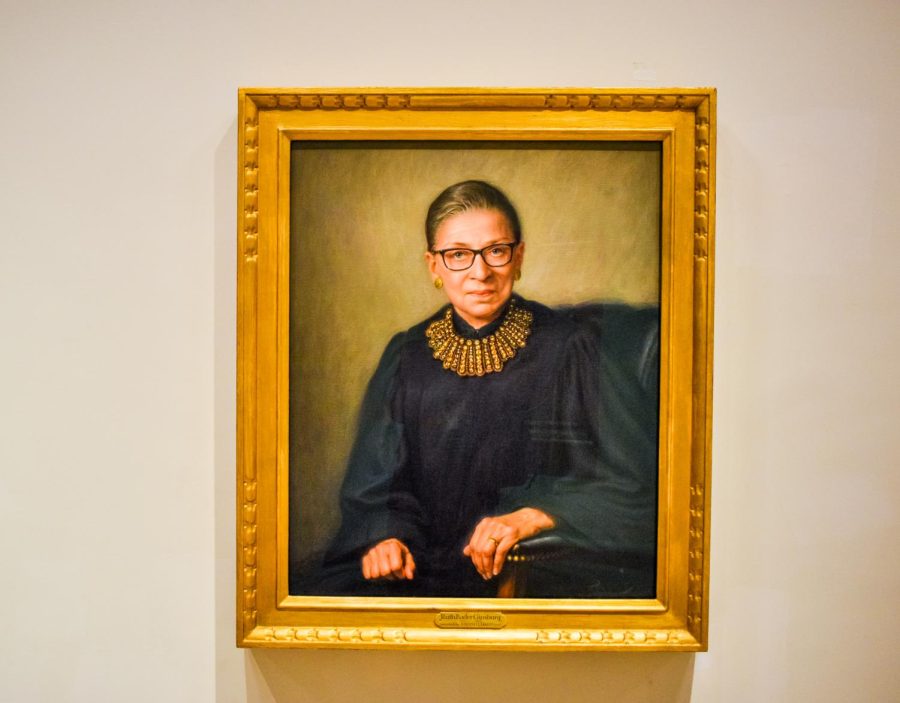A recognizable face has joined the paintings that line the Kirby Hall of Civil Rights’ second floor: the late Supreme Court Justice Ruth Bader Ginsburg.
The painting was commissioned with funds from the F. M. Kirby Foundation to celebrate the 100-year anniversary of the Fred Morgan Kirby Professorship of Civil Rights, a position funded by an endowment from Fred Morgan Kirby.
A committee spearheaded by Michiko Okaya, retired director of the Lafayette Art Galleries and Art Collection, in conjunction with the Kirby family and the F. M. Kirby Foundation, settled upon Ginsburg as the subject of the portrait, making her the first woman in the collection.
Joseph Q. Daily, who painted the portrait, was first approached with the idea in 2019.
“I was originally really excited about the prospect of actually meeting [Ginsburg] and having a sitting in-person like I usually do. When I can actually have a live sitting with the subject, then I’m taking the photographs myself, and I can really construct it,” Daily said. “With posthumous portraits, you just take from the best of what’s available.”
This limited reference point gave Daily an unexpected freedom with the portrait. With references to Ginsburg’s face and body being pulled from many different eras, the final portrait presents a rich composite image that clearly depicts Ginsburg but gives a blurred idea of her exact age.
Ginsburg’s hands in the portrait have been modeled after those of Daily’s mother, and the piece of chair visible under her arm is the chair that sits in Daily’s studio.
“The image is more or less a Frankenstein product of multiple sources,” Daily said.
The painting joins the Kirby Collection of Historical Paintings, a large collection started by Allan P. Kirby in 1943. The original purpose of the collection was to assemble a group of portraits of U.S. presidents in the Kirby Hall of Civil Rights, but over time, the collection has expanded its subjects.
Allan P. Kirby wrote in the preface of a 1963 catalog of the collection that the subjects of each piece are “bound together by a common bond; each is significant in terms of the historical or cultural development of this nation.”
The portrait of Ginsburg hangs to the left of the entrance to the Kirby Library and to the right of a portrait of Thurgood Marshall, which was commissioned by the school in 2016 from artist Ying-He Liu with funds from the F. M. Kirby Foundation.
Ginsburg and Marshall — the two most recent additions to the collection and the first portraits of a woman and person of color in the hall, respectively — represent a wider mission to broaden the diversity of the collection.
“We certainly want to see the concept of civil rights evolve and be updated and to reflect the historical progression of the concept,” Justin Kiczek, executive director of the F. M. Kirby Foundation, said.
Maurice S. Luker III, who sat on the committee that originally chose the painting of Ginsburg, agreed that expanding the identities represented in the collection was a crucial step.
“We want to think about how these things are not frozen in amber, that the collection is not static, that the people we admire change,” Luker said.
Luker pointed to Allan P. Kirby’s written philosophy of the collection, where he wrote, “Portraits of many others should and will be added when it is possible to acquire them.”
“Ruth Bader Ginsburg, she was not someone that Mr. Kirby knew or would have collected, but this is a living legacy,” Luker said. “It will keep growing.”















































